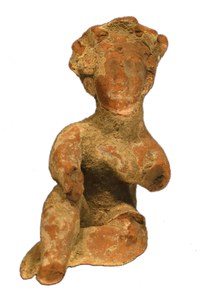Dionysus
|
Dionysus, Inv. T I-47 Worked by hand, face from the mould, wreath attached. Provenance: Acquired by Bruno Sauer, from the Margaritis Collection. State of preservation: Lost are the right hand, the left arm below the shoulder, the front section of the right foot and elements from the wreath. The left leg is broken in the thigh, a triangular fragment on the left side of the head partially reattached. Dimensions: H: 6,5 cm; W: 3,3 cm; D: 5,0 cm. References: Not published. |
Description: The unclothed, crowned boy figure assumes a seated position with bent, crossed legs. The genitals are indicated between the thighs. The arms were stretched forward; the right forearm touches the right knee. The head is slightly raised and turned slightly to the right. Beneath the wreath, which is composed of spherical fruits and small thick leaves, wavy strands of hair emerge without any recognisable internal division; they frame the low forehead and the smooth cheeks up to the level of the ears. The face tapers and shows a round, slightly receding chin. The small mouth is cut horizontally. The large eyes are surrounded by narrow lids.
Commentary: The statuette is a fully elaborated sculpture with a carefully worked back. The rubbed surface of the buttocks suggests that the boy was not sitting on a smooth but on an irregular surface, perhaps on the arm of a larger figure. The vegetal wreath connects him to the sphere of Dionysus, who in his childlike appearance may be sitting on the arm of a satyr or silen[1]. The posture of the lower extremities with the left leg crossed underneath is also encountered outside the Dionysian context, for example in the bronze statuette of a boy from the Peribolos of Opheltes in Nemea, which is thought to be Hellenistic[2]. The position of the legs differs from that of the so-called temple boys. They generally sit on smooth, flat surfaces and pull the flat left leg towards them without crossing the right leg underneath[3].
As far as the stylistic classification of the statuette T I-47 is concerned, the narrow cheeks and the body form, which correspond more to an adult than a small child[4], point to a pre-Hellenistic period. This contrasts with the luxuriant wreath familiar from numerous 'Dionysian' heads of the 2nd and 1st centuries BC, especially in statuettes from workshops in western Asia Minor[5]. Terracotta groups of the same period, such as Dionysus in the company of Ariadne[6] or with panthers and erotes[7], also show the youthful god with similarly richly decorated wreaths. Such a wreath could have been added to the less childlike head of the boy T I-47 in a later matrix moulding, e.g. to compensate for a loss of size caused by the kilning process or to adapt the figure to the changing taste of the time with an appliqué[8]. According to its most recent criterion, the wreath, the statuette will have been completed only in the Hellenistic period.
The landscape in which the small figure was created cannot be determined with certainty at present. The origin of the two comparative groups of satyrs with the childlike Dionysus on their arms, Pergamon and Myrina, suggests a workshop on the west coast of Asia Minor.
Determination: Hellenistic. From Asia Minor?
[1] Cf. papposiles with Dionysus boys from Pergamon, E. Töpperwein, Terrakotten von Pergamon (Berlin1976) 227 no. 392 pl. 56; T. Kekeç, Pergamon (Istanbul 1989) 106 fig. c; S. Mollard-Besques, Cat. raisonné des Figurines et reliefs en terre-cuite grecs et romains II Myrina (Paris 1963) 80 pl. 96 b; LIMC III (1986) 481 no. 695 pl. 380 s. v. Dionysos (C. Casparri).
[2] St. G. Miller, Excavations of Nemea, 1979, Hesperia 49, 1980, 192 pls. 42 a. b; Mind and Body (Athen 1988) 241 fig. 133; U. Liepmann, Griechische Terrakotten, Bronzen, Skulpturen. Kestner-Museum (Hannover 1975) 102 T 117.
[3] C. Beer, Temple-Boys (Jonsered 1993/94); H.-G. Buchholz – W. Wamser-Krasznai, Tempelknaben in Tamassos, RDAC 2007, 229-256 fig. 5 d; R. A. Stucky, Die Skulpturen aus dem Eschmun-Heiligtum bei Sidon (Basel 1993) 30-34 nos. 113-115 pl. 28.
[4] Cf. e.g. the childlike Eros with chubby cheeks and round belly in the group E 128, W. Hamdorf – F. Leitmeir, Die figürlichen Terrakotten der Staatlichen Antikensammlungen München (Lindenberg im Allgäu 2014) 401 E. 128 and pl. p. 346; Mollard-Besques ibid. 77-79 pl. 93-95.
[5] Myrina: D. Burr, Terra-Cottas from Myrina in the Museum of Fine Arts, Boston 1934, 53 pl. 21. 56 pl. 22; Mollard-Besques ibid. 161 f. pl. 196 b. e. g. 197 h; Troy: D. Burr Thompson, Troy (Princeton 1963) 135 no. 261 f. pl. 52; Pergamon: Töpperwein ibid. 234 no. 475 pl. 71.
[6] Mollard-Besques ibid. 78 f. pl. 94 f.
[7] s. note. 4.
[8] A young man sitting to the left of his companion, as seen from the viewer's perspective, was subsequently given a second wreath with teasels and rosettes, while the first beaded wreath, reduced in circumference, is moulded together with the figure, W. Wamser-Krasznai, Für Götter gelagert (Budapest 2013) 17. 127 fig. 56; H. Herdejürgen, Die tarentinischen Terrakotten des 6. bis 4. Jahrhunderts v. Chr. (Basel – Mainz 1971) 10-13; E. Jastrow, Abformung und Typenwandel in der antiken Tonplastik, OpArch 2, 1941, 3-7 pl. 5; G. Kleiner, Tanagrafiguren (Berlin 1942) 267 f.





